-
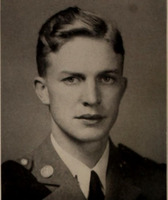
Senior class picture of Capt. Manny Lawton, Class of 1940, from Taps yearbook. Lawton graduated with a B.S. in general science.
-
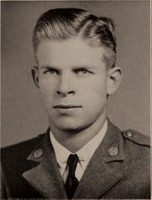
Senior class picture of Capt. William Cline, Class of 1941, from Taps yearbook. Cline received a B.S. in mechanical engineering.
-
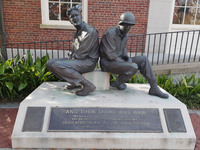
Commissioned by the Class of 1944 for its fiftieth anniversary, the Mell Hall Memorial was dedicated on Feb. 9, 1993. The project grew out of conversations that sculptor T.J. Dixon had with Clemson men who had served in World War II. “How can I make you understand?” said one veteran. “We were boys, mere boys, and then there was war and half of us were dead or wounded.” Together with James Nelson, Dixon captured this life-changing experience by depicting a carefree student sitting back-to-back with a weary soldier version of himself. Beneath the men, on either side of the veteran’s haunting words, are two plaques listing the fifty-three names of members of the Class of 1944 who were killed in the war.
-
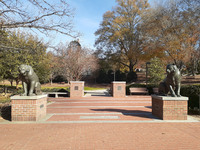
Dedicated in 2010, the Scroll of Honor Memorial was designed to commemorate Clemson students and alumni who have paid the ultimate sacrifice in the service of their country. The memorial includes a circular mound or barrow to represent the eternal values of duty, honor, and country and the unity of those who served. The names of the fallen are engraved randomly on the stones around the barrow, symbolizing the fact that there is no pattern to death in war. Only their names and class year are engraved on the stones; they share the common bond of Clemson men. The stones are mounted in the barrow at an angle so that visitors must bow their heads to read the names on the stones, as if in reverence to the memory of the heroes.
-
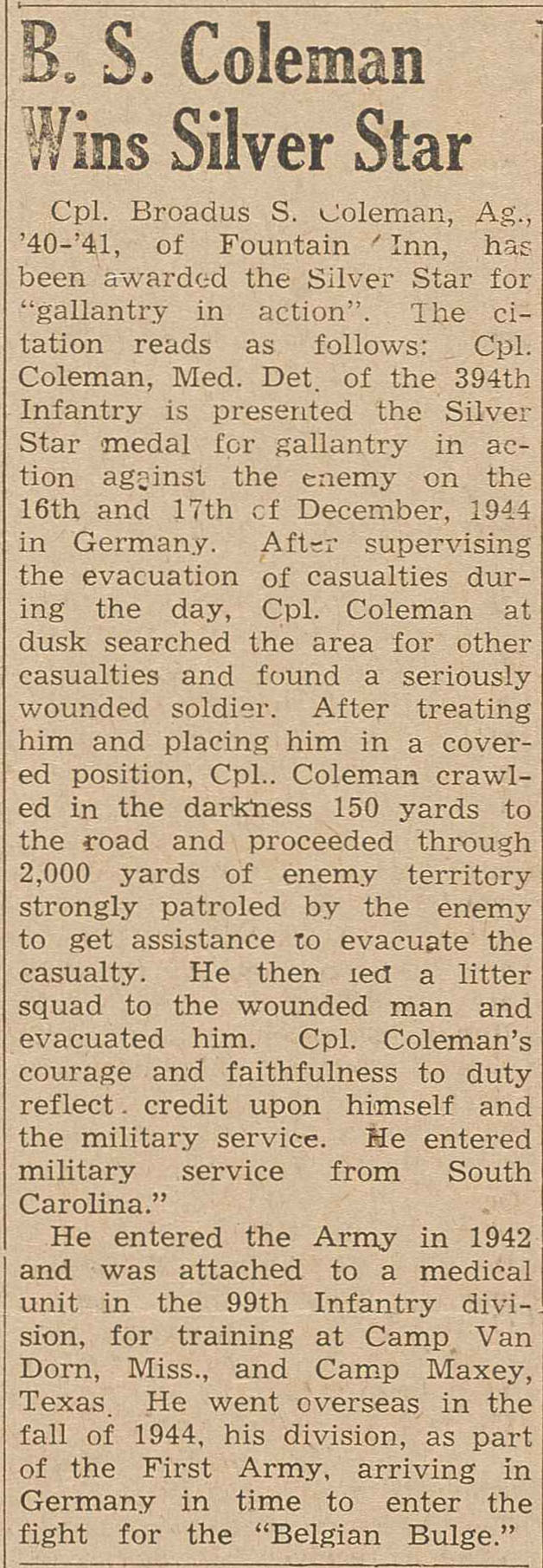
This article features the story of Cpl. Broadus S. Coleman, Class of 1940-41, who as a medic rescued a seriously wounded soldier from behind enemy lines on December 16-17, 1944 in Germany during the Battle of the Bulge.
-
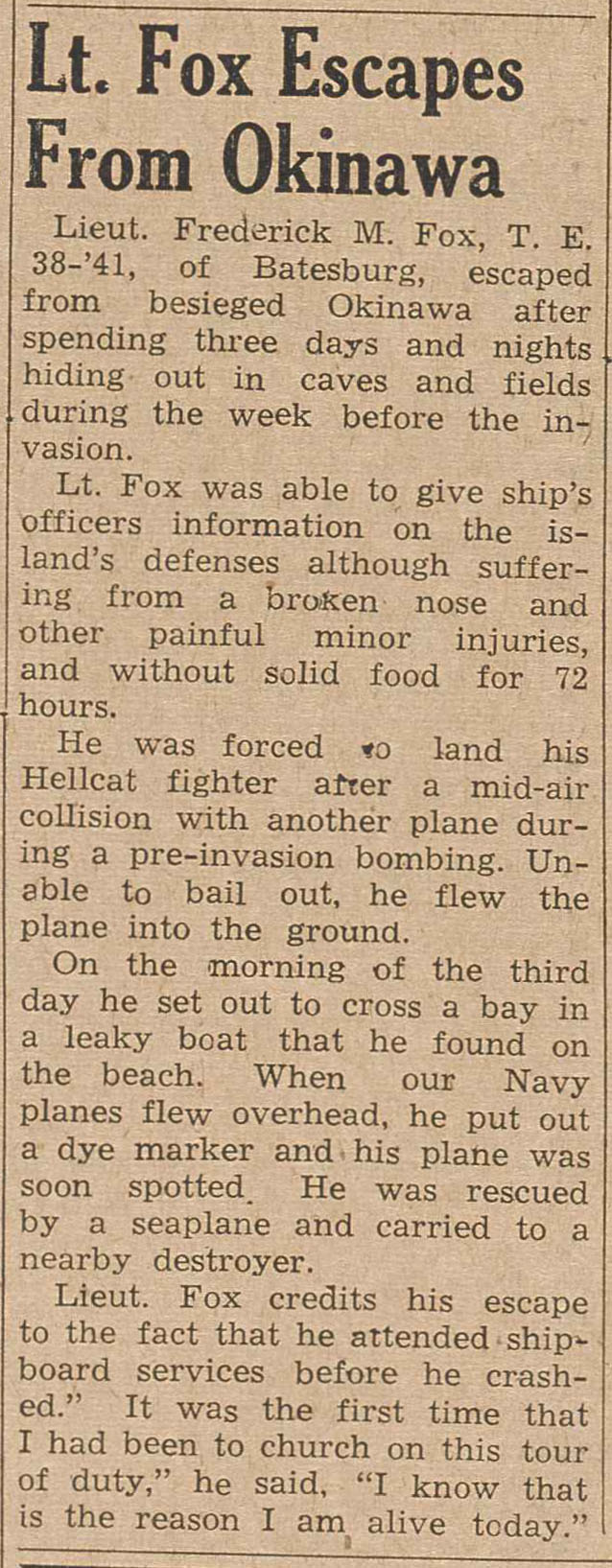
This article reports that Lt. Frederick M. Fox, Class of 1938-41, escaped from Okinawa after spending three days and three nights hiding out in caves and fields during the week before the Allied invasion. He had been forced to crash-land his Hellcat fighter. Suffering from injuries and lack of food, he managed to signal to Navy planes for rescue. He credits his escape to the fact that he attended shipboard services before he crashed: "It was the first time that I had been to church on this tour of duty. I know that is the reason I am alive today." It was indeed fortunate that Lt. Fox escaped, because he likely would have been killed if found by the Japanese or local Okinawans.
-

This article reports that Capt. George H. Dunkelberg, former professor of agricultural engineering, has returned home. He landed with the 101st Airborne in Normandy on June 7, 1944 and fought in France until his glider was shot down in September. He was captured by the Germans and sent to Oflag 64, a prison camp in Poland. When the Germans marched the prisoners west to evade the advancing Russians in the winter of 1944-45, Dunkelberg and two fellow officers escaped and hid with a Polish family for five days until the Russians arrived.
-

For many issues during the war, The Tiger included a section entitled "People at home and abroad" with news and stories about Clemson men in the service. The highlight of this edition is Maj. Harry Ashmore's hopes for his postwar life in the "so they say..." section. In the top center there was usually a box called "Clemson Heroes" featuring a Clemson man who had distinguished himself in battle, in this case Capt. Thomas Moffat Burris.
-

This article reports that three Clemson men have been released from German and Japanese captivity, while a fourth, Capt. George H. Dunkelburg, was seen fighting at the front with the Russians.
-
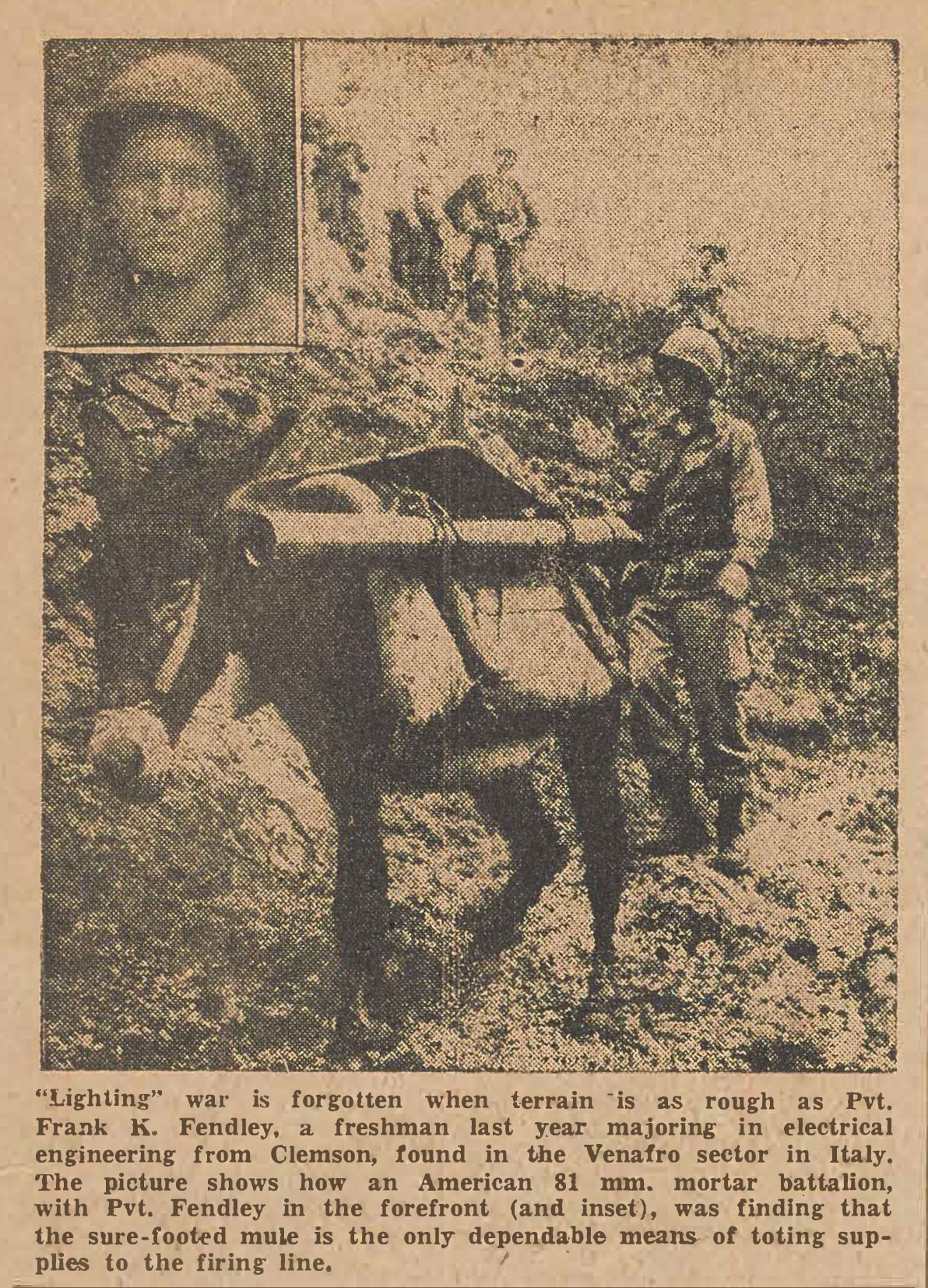
This captioned photograph printed in The Tiger shows Pvt. Frank K. Fendley, a former freshman at Clemson, slogging through the mud behind a supply mule, along with his mortar battalion in the Venafro sector in Italy. From autumn 1943 to the spring of 1944, Venafro was the scene of bitter fighting between the Germans, entrenched in the mountains to the north, and the Allies, along the Gustav Line, during the Battle of Monte Cassino. Fendley would later be promoted to Staff Sergeant and awarded the Purple Heart in Sept. 1943 after being wounded in the battle for Rome. He was killed on September 18, 1944.
-
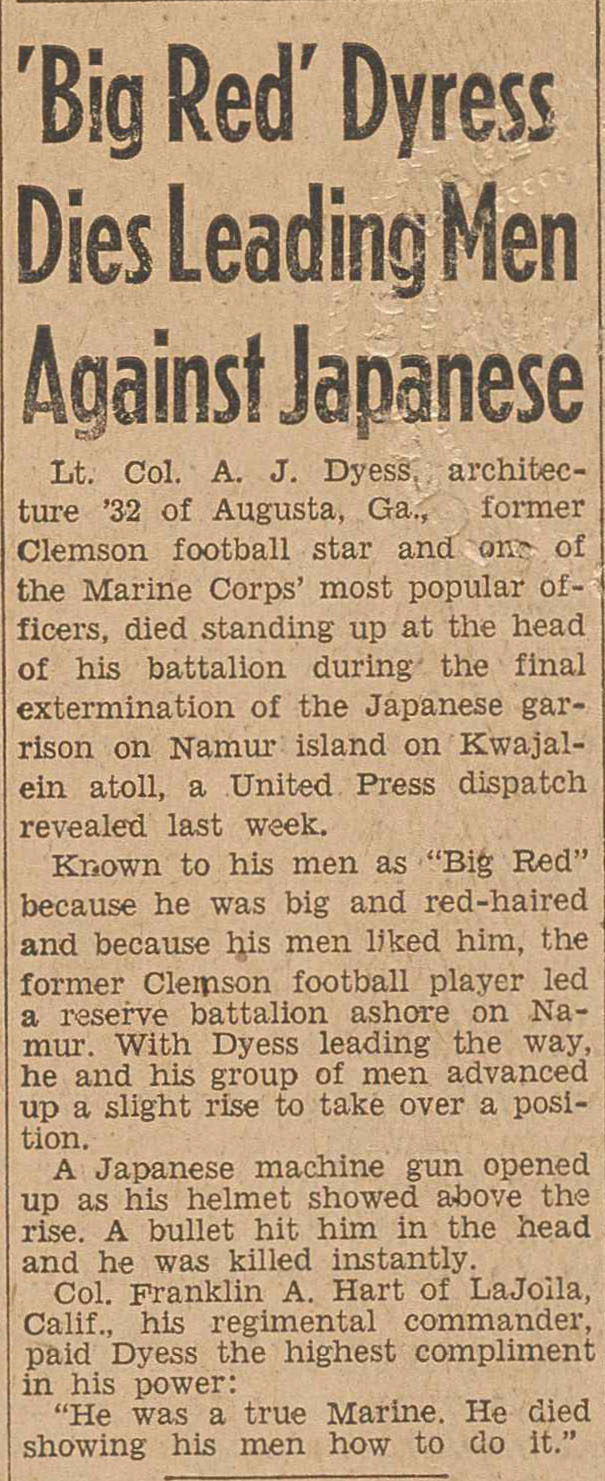
There are two articles, one from The Tiger and another written by Staff Sergeant Dick Tenelly, a Marine Corps combat correspondent. They feature the story of Marine Lt. Col. A.J. "Big Red" Dyess, Class of 1932, who was killed while leading his battalion against the Japanese garrison on Namur island on Kwajalein atoll on February 2, 1944 during the Battle of Marshall Islands.
-

This article features the story of Capt. Charles H. Hollis, Class of 1935, who was awarded the Silver Star for gallantry in action in Italy. When his tank column came under enemy fire, Hollis ran to a tank and directed fire from an exposed position on the turret until the enemy guns were neutralized.
-

This article features the story of Lt. Samuel R. Webster, Class of 1941, who commanded a tank platoon in North Africa until he was taken prisoner by the Germans on December 3, 1942. He later escaped from an Italian prison and was assigned to the Armored Replacement Training Center at Fort Knox.
-

This article features the story of Thunderbolt pilot Lt. John H. Truluck, Class of 1938, who shot down four German planes over enemy territory.
-

This article features the story of Lt. Earl Mazo, Class of 1940, who recently flew as an observer-gunner in a B-17 Flying Fortress during a bombing mission over Germany. According to Mazo, the German anti-aircraft was "like a keg of nails exploding, and it sounded like a keg of nails dumped on a tin roof when it hit the Fort[ress]."
-

This article features the story of Marine Corporal Leon Crawford, who participated in the Battle of Guadalcanal. On August 7, 1942, the US Marines, with naval and air support, launched a successful amphibious assault on the Japanese airfield on Guadalcanal in the Solomon Islands. As Cpl. Crawford recounts, the Marines faced fierce opposition from the Japanese, who made several attempts to retake the airfield by land, sea, and air. Often outnumbered, plagued by snipers, short of food and weakened by the heat and disease, the Marines held the island and prevented the Japanese island-hopping advance towards Australia.
-
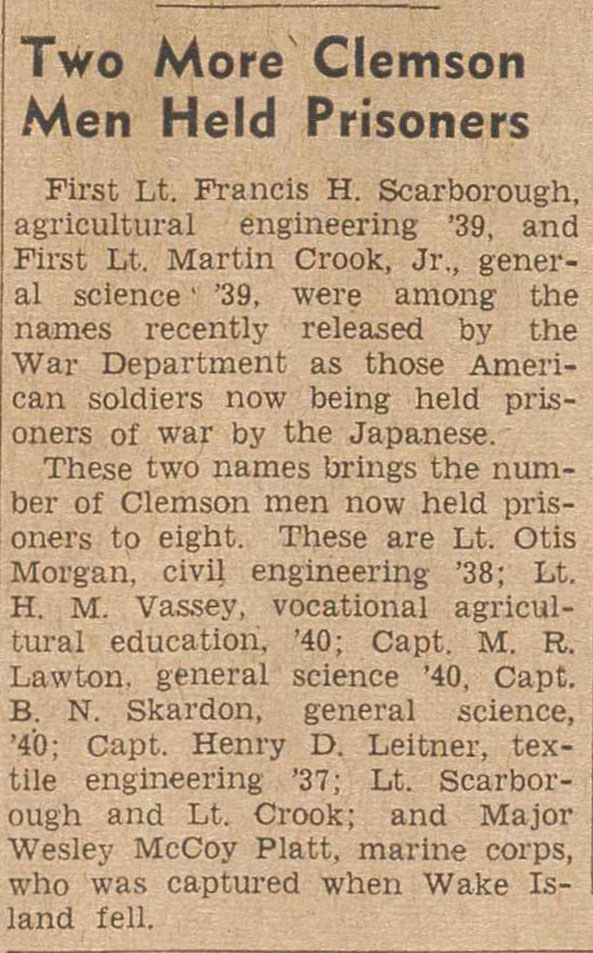
This article reports that two more Clemson men have been confirmed prisoners of the Japanese. The total is now eight: Lt. Otis Morgan, '38; Lt. H.M. Vassey, '40; Capt. M.R. Lawton, '40; Capt. B.N. Skardon, '40; Capt. Henry D. Leitner, '37; Lt. Francis H. Scarborough, '39; Lt. Martin Cook, Jr., '38; and Major Wesley McCoy Platt, marine corps.
-

This article reports that Capt. Manny Lawton, Class of 1940, has been taken prisoner by the Japanese. The news comes over nine months after his capture at Bataan.
-
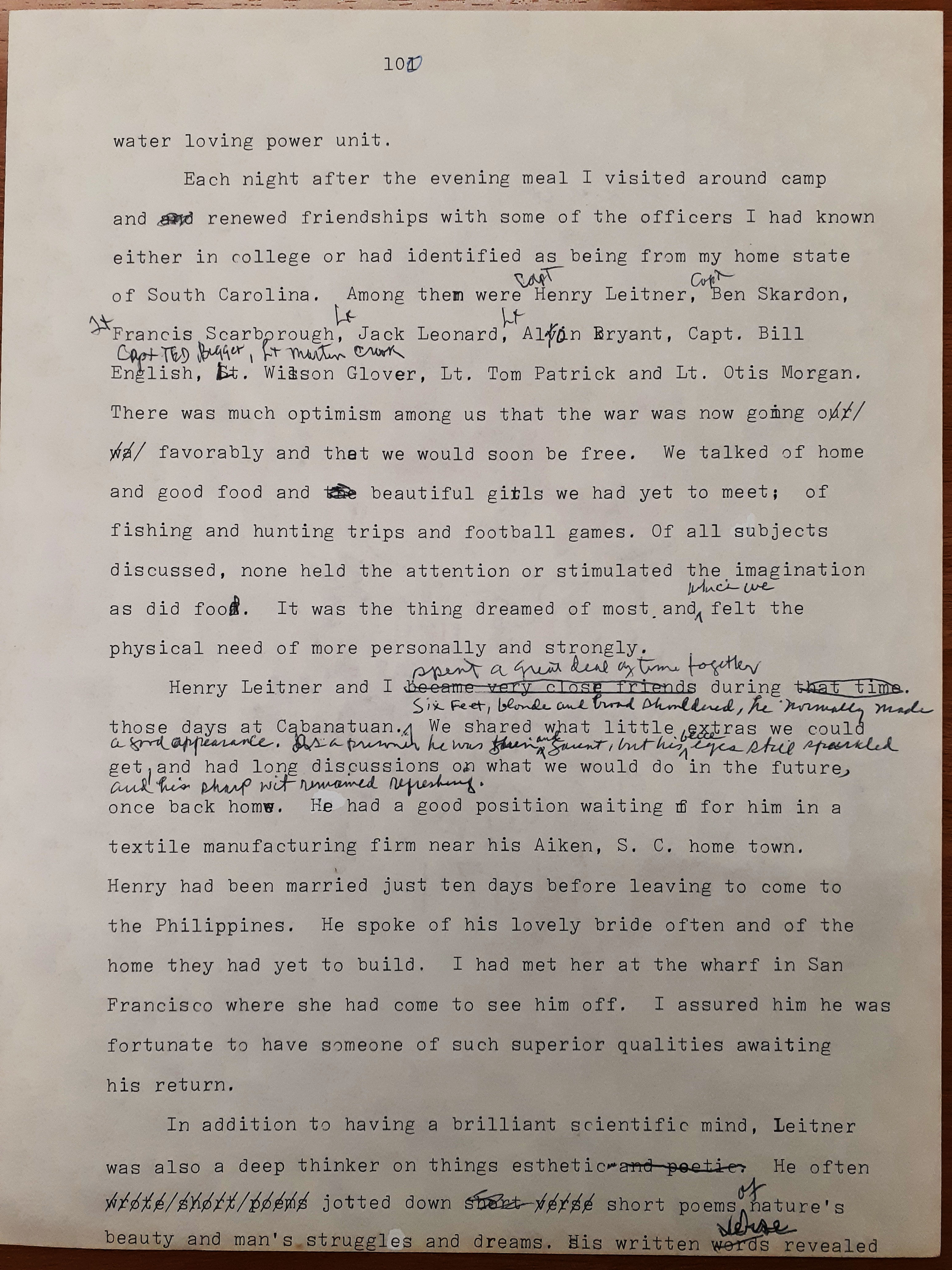
This is an annotated, typewritten draft page from Chapter 10, "Back to Cabanatuan," in Manny Lawton's memoir Some Survived. It describes Lawton's reunion with several Clemson men in the prison camp at Cabanatuan, among them Henry D. Leitner, with whom he developed a close friendship. Leitner would not survive the war.
-
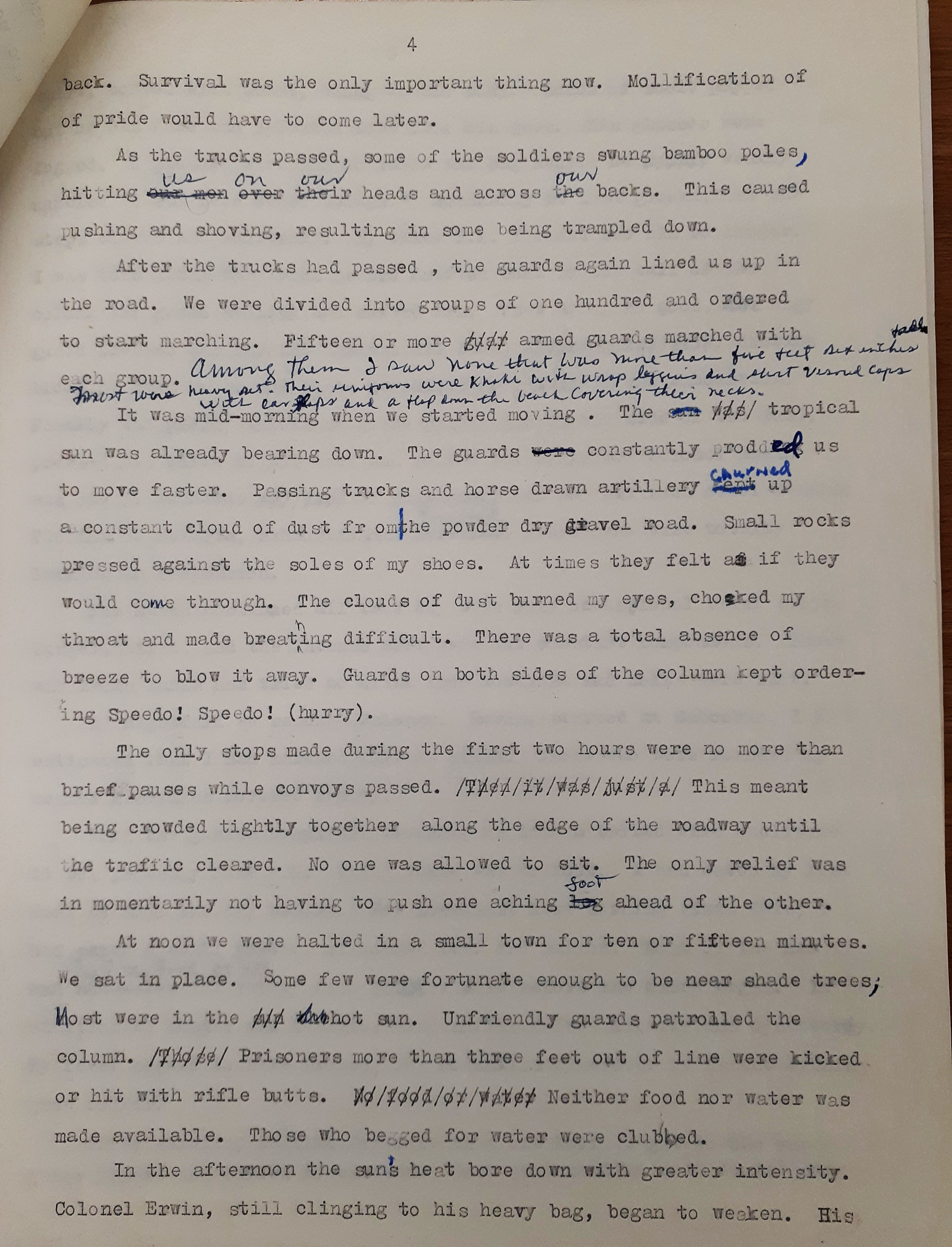
This is an annotated, typewritten draft page from Chapter 2, "The Death March," in Manny Lawton's memoir Some Survived. It describes the long forced march from Bataan to Camp O'Donnell. The prisoners had to walk about twenty-five miles a day in the scorching heat, with minimal food and water and few medical supplies, while the Japanese guards beat and taunted them.
-

This is an annotated, typewritten draft page from Chapter 1, "The Fall of Bataan," in Manny Lawton's memoir Some Survived. It describes the Japanese attack on Bataan on April 3, 1942.
-
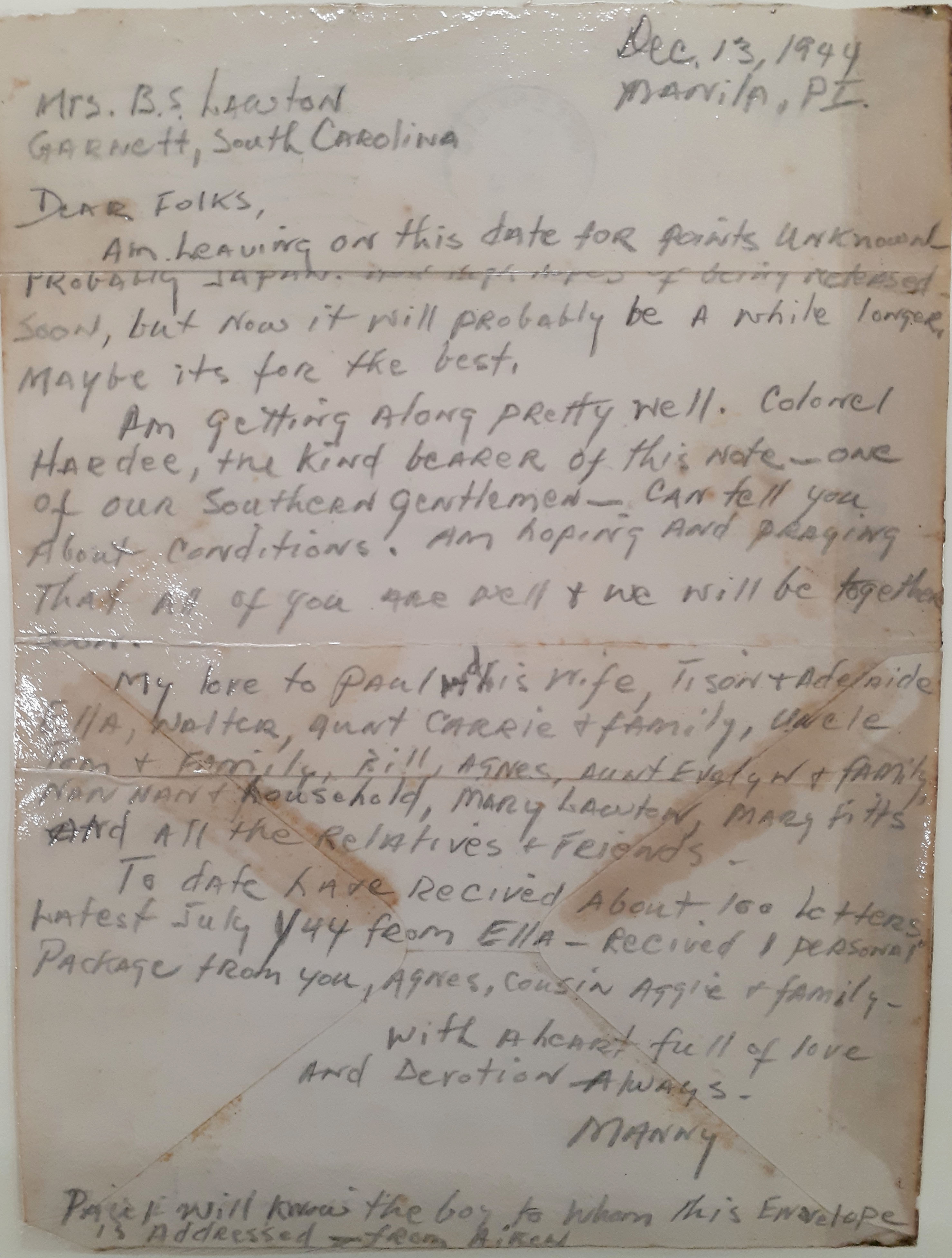
In this handwritten letter dated Dec. 13, 1944, Capt. Manny Lawton notifies his parents that he and his fellow POWs are being sent from Manila in the Philippines to an unknown location. He will make the long, harrowing journey to Japan in three successive voyages aboard unmarked "hell ships," which will be attacked by American planes. During these attacks, Clemson classmates Otis Morgan will be killed and Henry Leitner (whose address is on the envelope) mortally wounded. Lawton will arrive in Japan on Jan. 30, 1945.
-

In this typewritten letter to his parents, Capt. Manny Lawton, Class of 1940, describes the past months of fighting with the Philippine Army against the Japanese. Just one month later, he will be taken prisoner by the Japanese at Bataan.
-
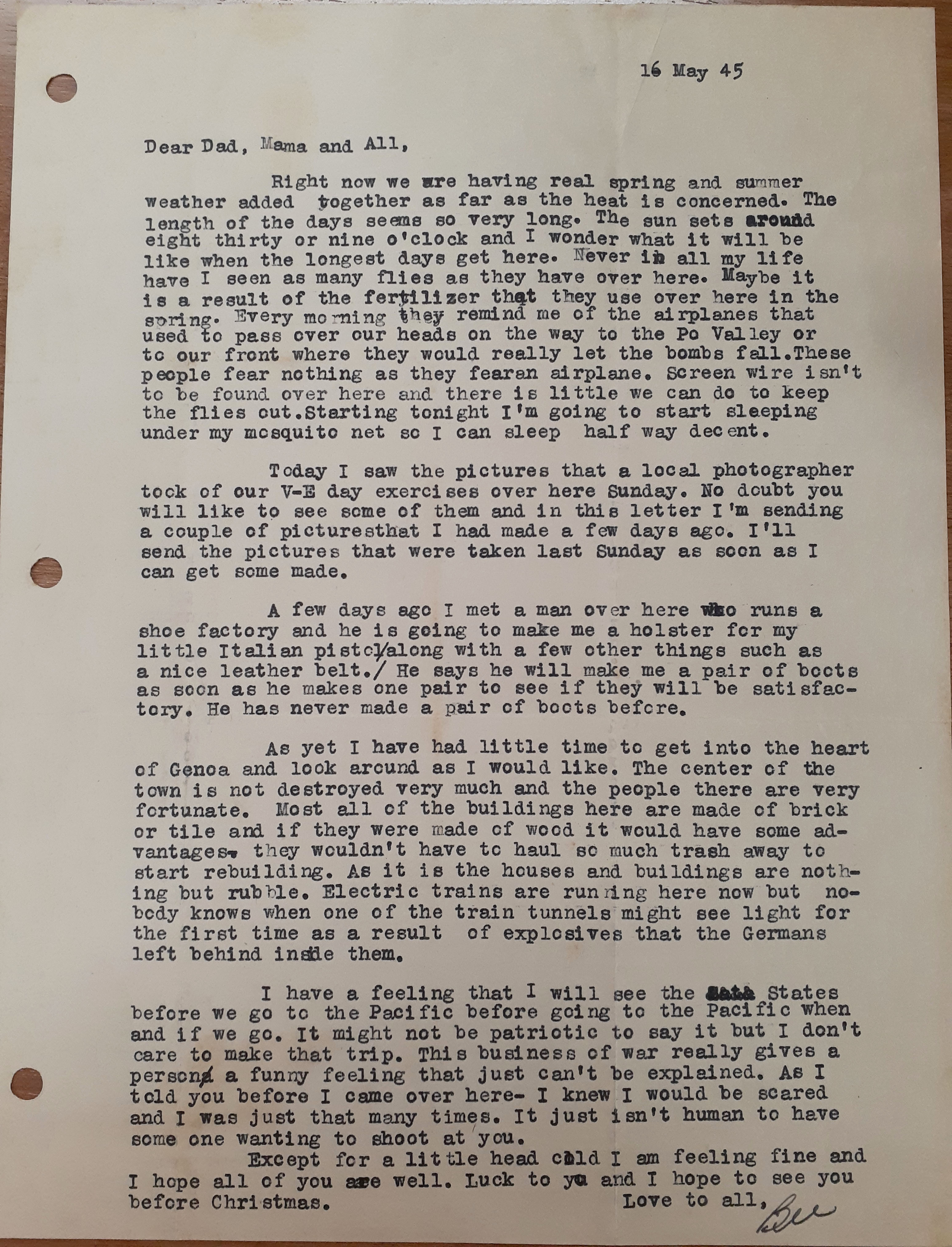
In this typewritten letter to his parents dated May 16, 1945, Capt. William Cline expresses his strong desire to be done with war: "I have a feeling that I will see the States before we go to the Pacific...when and if we go. It might not be patriotic to say it but I don't care to make that trip. This business of war really gives a person a funny feeling that just can't be explained. As I told you before I came over here--I knew I would be scared and I was just that many times. It just isn't human to have some one wanting to shoot at you."
-

In this typewritten letter to his parents on VE Day, Capt. William Cline discusses the end of the war in Europe and assures them that he has not been sent to the Pacific yet: "No doubt you might be thinking that I'm on another boat trip in the wrong direction but it is not that way...I still have the same desires that I have had for many months now...They can have their promotions, all I want is to get home." At the end he writes: "Right now we are sitting in suspense, hoping that we will get sent back to the states pretty soon. None of us care to see China or Japan. Everyone is thinking of nothing but home."
























